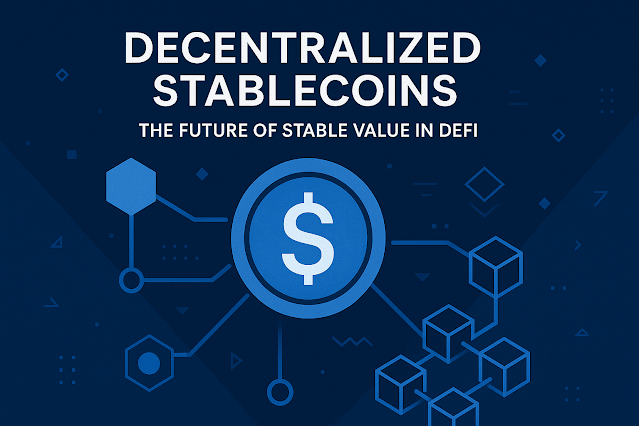Decentralized Stablecoins The Future of Stable Value in DeFi
1. Introduction to Stablecoins
Stablecoins are a class of cryptocurrency designed to maintain a stable value by pegs to external assets most commonly fiat currencies like the U.S. dollar, but also commodities or other cryptocurrencies. They emerged to solve the extreme volatility that plagues Bitcoin and many altcoins, enabling crypto‑native applications (especially in DeFi) to transact, lend, borrow, and hedge with minimal price risk.


Traditional stablecoins fall into four categories:
-
Fiat‑Collateralized (e.g., USDC, Tether USDT)
-
Commodity‑Backed (e.g., PAXG backed by gold)
-
Algorithmic (e.g., Terra USD, Ampleforth’s AMPL)
Decentralized stablecoins are those that avoid reliance on a central issuer meaning no single company or custodian holds reserves on behalf of users. Instead, they leverage on‑chain collateralization or algorithmic mechanisms to maintain their peg.
2. Crypto Collateralized Stablecoins
2.1 How They Work
Crypto‑collateralized stablecoins maintain their $1 USD peg by locking up volatile cryptocurrencies as collateral in smart contracts. Users deposit assets (like ETH or WBTC) over‑collateralized at ratios often between 110 % and 200 %. If the collateral’s market value falls below a minimum threshold, anyone can trigger liquidation: the smart contract sells collateral to buy back (and burn) the stablecoin, restoring the system’s solvency.
2.2 Example: DAI
-
Mechanism: Users lock various approved tokens in MakerDAO’s Vaults to mint DAI against them.
-
Governance: Maker (MKR) token holders vote on risk parameters (e.g., liquidation ratios, stability fees).
-
Scale: DAI’s market cap exceeds $5 billion, making it the leading decentralized stablecoin.
-
Risks:
-
Liquidation Cascades during rapid price crashes (e.g., March 2020’s “Black Thursday”)
-
Oracle Manipulation if price feeds are compromised
-
2.3 Benefits and Drawbacks
-
Benefits
-
Clear, on‑chain collateral backing
-
Decentralized governance and transparency
-
Resilience against censoring or seizure
-
-
Drawbacks
-
Requires locking up significant crypto capital
-
Liquidation risk in extreme volatility
-
Complex for end users to understand collateralization ratios
-
3. Algorithmic Stablecoins
3.1 Core Principle
Algorithmic stablecoins eschew traditional collateral. Instead, they dynamically expand or contract token supply via smart‑contracted “rebase” or “seigniorage” algorithms. When price > $1, the protocol mints new tokens (increasing supply); when price < $1, it burns tokens (reducing supply), aiming to steer market price back to $1.
3.2 Notable Projects
-
Ampleforth (AMPL) uses a daily rebasing mechanism to adjust user balances proportionally, targeting purchasing‑power stability rather than strict dollar parity.
-
Terra USD (UST) (now defunct) relied on an arbitrage incentive between UST and its sister token LUNA; its collapse in May 2022 wiped out $60 billion and exposed grave design flaws.
-
Frax (FRAX) pioneered a hybrid model: partially backed by collateral and partially algorithmic, aiming to balance stability and capital efficiency.
3.3 Strengths and Weaknesses
-
Strengths
-
Lower capital requirements (no full collateral needed)
-
Potentially more elastic and adaptive supply
-
Novel incentive mechanisms to engage community
-
-
Weaknesses
-
Highly sensitive to market sentiment (“lack of trust = depeg”)
-
Complex behavior that can confuse users
-
Vulnerable to cascading failure if algorithm assumptions break
-
4. Transparency & Resilience in Volatile Markets
Decentralized stablecoins promise on‑chain transparency anyone can audit reserves, collateral positions, and protocol parameters in real time. This visibility builds trust, especially when centralized issuers face regulatory or operational risks.
Meanwhile, resilience comes from decentralized participation: no single custodian can halt redemptions, and liquidations are handled automatically by code. Crypto‑collateralized models weather price swings via over‑collateralization, while algorithmic models adapt supply dynamically though both require robust risk parameters and continual governance vigilance.
5. Protocol Case Studies
5.1 MakerDAO’s DAI
Mechanism & Evolution
MakerDAO’s DAI was launched in late 2017 as a crypto‑collateralized stablecoin on Ethereum. Users lock ETH and other approved tokens in Vaults (formerly CDPs) at over‑collateralization ratios (150 %+), minting DAI against their collateral. If collateral value falls below the liquidation threshold, it’s auctioned off to buy back and burn DAI, restoring solvency.
In 2019, Maker transitioned from Single‑Collateral DAI (ETH only) to Multi‑Collateral DAI, adding assets like BAT, USDC, and tokenized real‑world assets. This diversification reduced reliance on a single volatile asset but introduced debates around partial reliance on USDC a centralized token raising “re‑centralization” concerns.
Governance & Risk Parameters
Scale & Performance
As of mid‑2025, DAI’s market cap exceeds $5 billion, underpinning lending and trading across DeFi. MakerDAO’s on‑chain transparency allows anyone to audit Vault health, collateral composition, and protocol revenue, which is used to buy and burn MKR, creating a feedback loop aligning token value with system usage.
5.2 FRACTIONAL ALGORITHMIC HYBRID: FRAX
Hybrid Model
Frax Finance pioneered a two‑token system combining partial collateralization (e.g., USDC) and algorithmic balancing via its governance token FXS. The Collateral Ratio (CR) floats (typically 70–90 %) based on market demand: if FRAX > $1, CR gradually decreases (more FXS burned, less USDC needed); if FRAX < $1, CR increases (more USDC required).
Peg Stability & AMOs
To ensure deep liquidity, Frax integrates with Curve’s FRAX3CRV pool. Its “AMO” (Automated Market Operations) module allocates excess collateral and FRAX into the pool to stabilize the peg. Arbitrageurs can always mint or redeem FRAX at $1, extracting USDC +/– FXS, keeping on‑market supply in check.
Governance Shifts
In early 2023, Frax holders approved FIP‑188 to phase out algorithmic backing, targeting 100 % collateralization over time in response to broader regulatory scrutiny of non‑fiat‑backed stablecoins. This pivot underscores the fragility of purely algorithmic models and the market’s preference for transparent collateral.
5.3 ALGORITHMICS UNRAVELED: Terra USD (UST)
Design & Reflexivity
UST paired with LUNA in a reflexive cycle: burning LUNA to mint UST when UST > $1, and burning UST to mint LUNA when UST < $1. Anchor Protocol’s unsustainable 20 % APY fueled UST demand, further inflating LUNA’s market cap and enabling more UST issuance.
Collapse Timeline
On May 7–9, 2022, large UST redemptions and strategic withdrawals on Curve broke the peg, triggering panic withdrawals from Anchor. LUNA hyper‑minting to defend the peg led to a death spiral: LUNA’s supply exploded, its price collapsed from $80 to fractions of a cent, and UST lost almost all value by May 11, 2022.
Aftermath & Lessons
The collapse wiped out $60 billion in market cap and drew regulatory fire. Terraform Labs and Do Kwon faced fraud verdicts in the U.S., highlighting the perils of over‑reliance on unsound yield incentives and unchecked reflexivity in algorithmic models .
6. Governance & On‑Chain Risk Management
Decentralized stablecoins rely on protocol governance token‑based voting and on‑chain parameter changes to adjust risk controls dynamically:
-
Parameter Voting
-
Stability Fees, Collateral Ratios, and Debt Ceilings are proposed as Improvement Proposals (e.g., Maker Improvement Proposals, FIP for Frax) and executed on‑chain if quorum and approval thresholds are met.
-
-
Emergency Modules
-
MakerDAO’s Emergency Shutdown can halt new issuance and allow users to withdraw collateral at market value if systemic risk spikes.
-
Frax and Terra lacked robust emergency brakes, contributing to their respective governance crises.
-
-
Transparency & Oracles
-
Reliable price oracles (e.g., Chainlink TWAPs) feed real‑time asset valuations into smart contracts. Governance stewards can vote to switch or adjust oracle sources if data quality issues arise.
-
-
Community vs. Centralized Stake
-
Decentralized governance can be thwarted if a small cohort (or VC investors) holds outsized voting power as seen in Maker’s Endgame debate over MKR distribution and Frax’s nearly unanimous FIP‑188 vote.
-
7. DeFi Use Cases for Decentralized Stablecoins
Decentralized stablecoins have become foundational to a wide range of DeFi applications:
-
Lending & Borrowing Protocols
Platforms such as Aave and Compound allow users to supply stablecoins (e.g., DAI, USDC) as collateral or liquidity, earning interest while enabling others to borrow against these assets without credit checks. -
Automated Market Makers (AMMs)
Stablecoins power liquidity pools on Uniswap, Curve, and Balancer. Low‑slippage stablecoin pools (e.g., DAI/USDC on Curve) make large trades more efficient and reduce impermanent loss for liquidity providers. -
Yield Farming & Staking
Yield‑aggregators like Yearn Finance optimize stablecoin allocations across protocols to maximize APY (often in double‑digits), auto‑compounding returns for users who lock up DAI or DAI‑pegged tokens. -
Synthetic Assets & Derivatives
Protocols like Synthetix use stablecoins (e.g., sUSD) as collateral to mint synthetic exposures to stocks, commodities, and forex, democratizing access to these markets on‑chain. Decentralized derivatives platforms also settle futures and options in stablecoins, simplifying margin calculations. -
Cross‑Border Payments & Remittances
Stablecoins enable near‑instant settlement across borders with minimal fees. Integrations like Circle + Visa allow merchants to accept USDC globally, while individual remitters can send stablecoins instead of traditional wire transfers. -
DAO Treasury Management & On‑Chain Payroll
DAOs and Web3 startups hold treasuries in stablecoins for budget stability. Superfluid streams USDC salaries, and Gnosis Safe vaults manage multi‑sig holdings, ensuring transparent, programmable payroll and grants. -
Risk Management & Insurance
Stablecoins underpin DeFi insurance products users pay premiums in DAI or USDC to hedge smart‑contract or oracle failure risks, with claims settled in stablecoins for predictability.
8. Regulatory Outlook for Stablecoins in 2025
United States
-
GENIUS Act (S. 1582): Passed the Senate on June 17, 2025, this bipartisan bill establishes a federal‑state dual supervisory framework, stringent reserve and audit requirements, and consumer protections for payment stablecoins. The House plans “Crypto Week” votes starting July 14, signaling likely enactment soon.
-
FIT21 Act (H.R. 4763): Approved by the House on May 22, 2024, FIT21 clarifies digital‑asset jurisdiction: the CFTC oversees truly decentralized blockchains as commodities, the SEC regulates securities-like assets, and permitted stablecoins are exempt from dual regulation (except anti‑fraud).
European Union
-
MiCA Regulation (EU 2023/1114): Fully applicable since December 30, 2024, MiCA requires stablecoin issuers to qualify as Electronic Money Institutions, maintain 1:1 reserves, submit disclosures, and comply with capital and redemption mandates. Algorithmic stablecoins are effectively prohibited.
Asia & Other Jurisdictions
-
Singapore (MAS Framework, Aug 2023): Defines stablecoins as digital payment tokens, mandates disclosure, capital requirements, and redemption within five days.
-
South Korea (VAUPA, Jul 2024): Exchanges must segregate assets, hold insurance, and prepare for stablecoin reserve and custody obligations coming in 2025.
-
Hong Kong (Stablecoin Bill, 2025): Poised for passage this year, with a regulatory sandbox already in place to foster compliant innovation.
Global Trends
Policymakers increasingly emphasize AML/sanctions compliance and systemic‑risk mitigation. Tokenized Money Market Funds have emerged as pseudo‑money instruments similar to stablecoins but regulated as securities a potential competitor and complementary form of digital collateral. Overall, 2025 is shaping up as a watershed year for stablecoin regulation worldwide.
9. Future Innovations in Stablecoin Architecture
Cross Chain DeFi & Interoperability
-
Zero‑Knowledge Bridging: ZK proofs will secure and accelerate cross‑chain transfers, reducing exploits by over 60 % according to Electric Capital.
-
Intent‑Based Execution & AI Agents: Protocols like Anoma and CowSwap will route transactions optimally across chains, while AI bots autonomously manage liquidity and hedging strategies.
Hybrid Monetary Ecosystems
-
Private Public Integration: A two‑layer design where private stablecoins are backed by central‑bank reserves, providing programmability and trust. Econometric models show such hybrids could prevent panic‑driven depegs, as analyzed in Wen & Li’s “Hybrid Monetary Ecosystems” paper (May 2025).
CBDC & Bank Token Trials
-
Project Acacia (Australia): RBA’s trial with major banks on CBDCs, stablecoins, and bank‑deposit tokens will test 24 real‑and‑simulated use cases until Q1 2026, exploring wholesale CBDC integration and improved collateral efficiency.
Novel Protocol Designs
-
Universal Payment Channels: A hub‑and‑spoke model enabling seamless token transfers across disparate chains, promising scalability and near‑instant settlement for any digital currency.
-
Hybrid Stabilization Protocols: Combining crypto‑collateralization, algorithmic futures (SFCs), AI‑driven arbitrage, and zkSNARK AML proofs to balance decentralization, stability, and compliance in cross‑chain contexts.
AI & DePIN Synergies
-
deAI Platforms: Decentralized AI networks will leverage stablecoin‑based incentives to fuel model training and data sharing securely on‑chain.
-
DePIN (Decentralized Physical Infrastructure Networks): Sensor and device networks (e.g., telecom, energy) will use stablecoins to reward participants, bridging real‑world services and tokenized economies.
Frequently Asked Questions (FAQs)
Like
Share
# Tags
